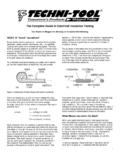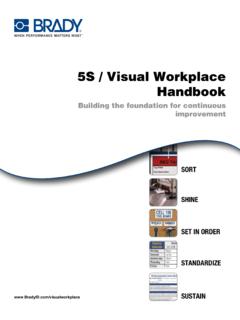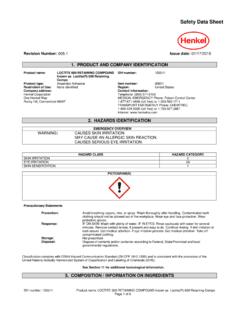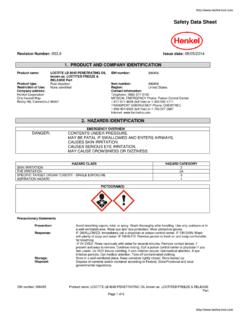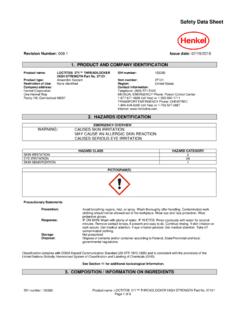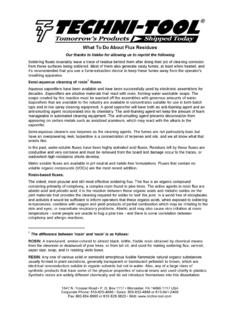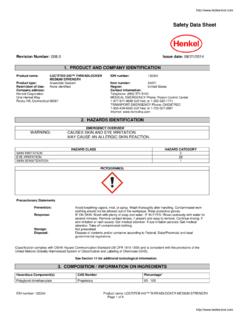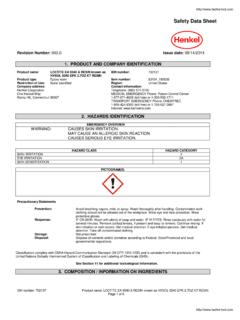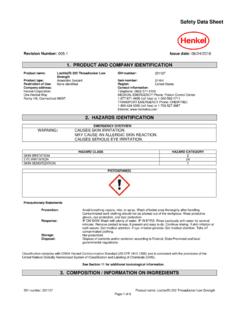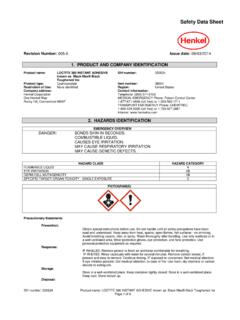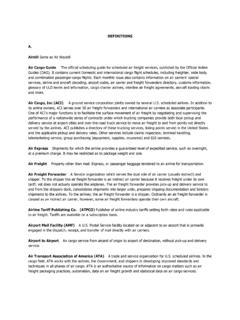Transcription of A Review of Test Methods and Classifications for …
1 FROM ONEENGINEER TO ANOTHER 1 From One Engineer To Another 1A Review of Test Methods and Classi cations for Halogen-Free Soldering MaterialsAuthored by: Jasbir Bath1, Gordon Clark2, Tim Jensen3, Renee Michalkiewicz4 and Brian Download article Share with a friendAQR (quick response) code contains encoded data. When scanned with a smart phone s camera (via a QR reader application), it will take you to a speci c URL or text the last few years, there has been an increase in the evaluation and use of halogen-free soldering materials. In addition, there has been increased scru-tiny into the level of halogens and refinement of the definition and testing of halogen-free soldering materials. The challenge has been that there has been no common standard across the industry in terms of halogen-free definitions and the corresponding test Methods to determine these.
2 This has created confusion in the industry as to what end users want and what soldering materials suppli-ers can actually provide. This paper will Review the status of both halogen-free and halide-free in terms of definitions, test Methods and the limitations and accuracy of test Methods used to determine if a soldering material is halogen/halide-free or not. For halogen-free and halide-free definitions, the paper will Review the different industry standards which are currently available and those being drafted, and it will discuss any similarities and differences. It will also cover the origins of some of the definitions mentioned in the standards. The paper will include a Review of the accuracy and limitations of several test meth-ods and preparation techniques for halogen and halide Associates Koki Solder, Santa Ana, CA; 2 Koki Solder, Scotland; 3 IndiumCorporation, Utica, NY; 4 Trace Laboratories Inc.
3 , Hunt Valley, MD; 5 Henkel Technologies, Irvine, CAIntroductionIn the electronics industry, there is a significant push toward halogen-free products. This movement is due to legislation from various countries, and public outcry from well publi-cized negative third world recycling practices, as well as non-government organizations (NGOs) testing and publishing information on electronic devices regarding their content of vari-ous potentially hazardous materials. Halogen-free products are also being mandated by certain OEMs as a means to lessen potential chemical effects on the electronics assemblies, halogens can be found in the plastics for cables and housings, board laminate materi-als, components, and soldering fluxes and pastes. In solder pastes and fluxes, the halogenated compounds are used as activators that remove oxides to promote solder wetting.
4 Eliminating TIM JENSENTim Jensen, Product Manager, PCB As-sembly Materials, Indium Corporation, has spent over a decade troubleshoot-ing and optimizing SMT process lines. He works closely with Indium s Techni-cal Service, Research & Development, and Sales Teams to ensure that Indium continues to o er cutting edge products to meet unique challenges in the electronics assembly industry. Tim is an SMTA-Certi ed SMT Process Engineer. email: Full biography: Corporation Tech PaperIndium Corporation Tech PaperFrom one engineer To Another 2the halogenated compounds can have a significant negative effect on the board assembly process. Process assembly challenges are not the only issues elec-tronics assemblers face as they become halogen-free.
5 The use of proper test methodologies to determine that the soldering products are actually halo-gen-free is currently not well defined as there are a variety of test Methods and standards in the industry. Halide content has been measured ei-ther qualitatively or quantitatively with halide testing being specified for more than fifty years with standards such as the United States Federal Specifica-tion QQ-S-571 standard [1] followed by MIL-F-14256 [2] and IPC-SF-818 [3] standards and currently in standards such as IPC J-STD-004 [4]. The speci-fications have listed requirements for the halide content of flux-containing soldering materials. The terms halogen and halide have caused confusion in the electronics in-dustry with definitions to try and clear up the confusion provided by standards such as JEITA ET-7304 [5] and IPC-J-STD-004 [4].
6 The term halogen refers to all halogen family elements and hal-ogen compounds including those which are present in nature. The JEITA ET-7304 standard [5] specifically targets the halogen families of chlorine (Cl), bromine (Br) and Fluorine (F) used as the activators for soldering materials. The term halide is defined as the halide ion or halide salt compound having an ionic character ( Cl-, Br-, F-). Covalently bonded halogens do not disassociate in water, and therefore the chloride, bromide and fluoride are still attached (covalently bound) to other species (typically organic), and will not be detected by techniques such as ion chromatography or titration. Ionically bonded halogens do disassociate in wa-ter into the negatively charged halide ion (Cl-, Br-, F-, etc.)
7 And the positive-ly charged species (H+, Na+ etc.). Test Methods used to look for ionic species, such as ion chromatography, will only detect halides. A better understanding of the test meth-ods, what they are capable of detecting in terms of halides and halogens, and how they relate to the various halogen-free definitions and standards is re-quired. A variety of these test Methods and standards will be discussed in the following sections as well as some test preparation variety of halogen-free definitions and standards have been developed in the electronics industry based on PCB laminates, components and soldering materials. The developed standards for PCB Laminates include IEC 61249-2-21 [6], JPCA-ES-01 [7] and IPC-4101 [8].
8 All three standards indicate less than 900ppm Cl (< %), less than 900ppm Br (< %) and less than 1500ppm total Cl and Br (< % Cl + Br).The developed standards for compo-nents include JEDEC JEP709 standard [9]. This standard indicates that a solid state device must meet the follow-ing requirements to be defined as low halogen in terms of less than 1000ppm Br (from BFR [Brominated flame re-tardants] sources), less than 1000ppm Cl (from CFR [Chlorinated flame re-tardants], PVC [Polyvinyl Chloride] and PVC co-polymers sources). For the PCB laminates used in components the Cl and Br limits would follow the guideline in IEC 61249-2 standard [6].The developed standards for soldering materials include JEITA ET-7034 [5] and IPC J-STD-004 [4].
9 The JEITA ET-7034 standard [5] states halogen content less than 1000ppm Cl, less than 1000ppm Br and less than 1000ppm F. An updat-ed draft of the JEITA standard, JEITA ET-7034A [10], also includes Iodine (I) with a value of less than 1000ppm. In contrast, the IPC J-STD-004[4] docu-ment does not currently have a require-ment for halogen content. J-STD-004 standard [4] only specifies a halide con-tent less than 500 ppm total halide. The amendment to J-STD-004 [4] currently being added does include optional test-ing for halogen content and is leaning towards the 900ppm Cl, 900ppm Br and 1500ppm total halogen content suggest-ed requirements. Test Methods used to determine Halide/Halogen ContentThe test Methods used to analyze for halides and halogens are outlined in the following section.
10 Silver Chromate Paper Test for Bromide and Chloride (halide)The Silver Chromate paper test method based on IPC J-STD-004 [4] and IPC TM-650 [11] is a qualitative test in which a sample of flux is applied to Silver Chromate Paper and allowed to remain on it for one minute. If the paper changes color then it indicates the presence of Chloride or Bromide. This test only identifies the halogen in the ionic form (halide) and is prone to false positives from chemicals such as amines, cyanides, and isocyanates. It also provides no indication as to the total halogen Spot Test for Fluoride (halide)The fluoride spot test method based Indium Corporation Tech PaperFrom one engineer To Another 3on IPC J-STD-004 [4] and IPC-TM-650 [12] is a qualitative test and is designed to determine the presence (if any) of fluoride(s) in the soldering flux by visual examination after placement of a drop of liquid test flux in a zirconium - alizarin purple lake.
